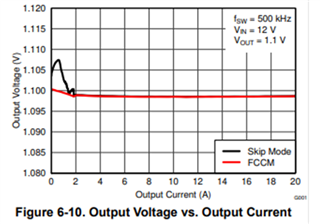If using skip mode, a higher VOUT is expected at a light load when compared to a heavier load when the device is operating in CCM. This is not an artifact of the reference voltage (or feedback voltage) changing as a function of load current. It has to do with the control logic in skip mode at light loads. When in skip mode, the TPS53353 acts in a similar fashion to a constant on-time controller where the on-time of each pulse is approximately the same, and the controller will fire a SW node pulse as the FB voltage crosses its reference voltage of 0.6V. The off-time then varies with load current when the device is in skip mode. This can lead to a slightly higher average output voltage at light load. If the application cannot tolerate that, I would recommend FCCM, but this will sacrifice some efficiency at lighter load currents.
Figure 6-10 in the datasheet demonstrates this behavior:


